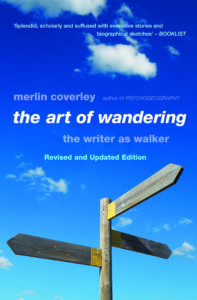Book Review – December 2022
For such a seemingly innocuous activity, and one which is commonly conducted with the participant largely oblivious to its operation, the act of walking has aquired a surprising degree of cultural significance.

This is a revised and updated version of Merlin Coverley’s book which was first issued in 2012. He uses this new edition to include material from works published since that date. He has also, as he alludes to in his new preface to this work, made a conscious effort to try to break free from from the grip of the boys’ club that psychogeography and flânerie seems to have become in recent years. In doing so he readily acknowledges his debt to works by Lauren Elkin, Kerri Andrews and Annabel Abbs.[i] Notwithstanding that, most of the writers discussed in this edition of The Art of Wandering: The Writer as Walker are still men – so says the male reviewer about the male writer, fully aware of the irony of his observation.
Coverley’s central contention is that the act of walking and a particular strand of writing are inextricably linked. There is a canon of literature, he asserts, for which walking is the narrative, the creative stimulus and the inspiration. Coverley’s extensive review of his subject matter takes us from the classical world to to the ubiquitous urban explorations of latter-day psychogeographers. For the ancient Greeks, he concludes, walking was nothing more than a means to an end; whereas, for many of today’s Gore-Tex-clad explorers, the act of walking is the whole point.
Coverley considers his thesis through a series of chapters that follow a roughly chronological order. Each chapter also focuses on a particular aspect of the link between walking and writing. The Walker as Philosopher examines early thinkers, such as Rousseau, for whom walking was part of the process of their philosophical writing. The Walker as Pilgrim, on the other hand, covers the period of the spread of Christianity throughout Europe through to the age of the romantic poets, writers and composers.
The Walker as Vagrant considers the works of Rimbaud and Verlaine and The Walker and the Natural World takes us from the Romantics through to Thoreau. Coverley, in the section headed The Walker as Visionary, pays particular attention the the writings of Arthur Machen, whose contribution to the literature of walking he asserts is unjustly neglected. Indeed, he borrows the title The Art of Wandering as a homage to Machen. Writing about Machen’s The London Adventure he suggests:
For while he was, on the one hand, to celebrate London in all its immensity and to revel in the occult preoccupations of his fiction, his own response to the endless horizon of streets within which he found himself was that of an overwhelming sense of awe, bordering on outright terror.
The unknown menace lurking in the city streets was, of course, anticipated by James Thomson a generation before in his The City of Dreadful Night. But Machen’s great achievement was a painstaking and systematic exploration of London’s ever-expanding network of streets.
At the heart of Coverley’s book is an examination of those writers who consciously incorporate walking into their writing practice. The Flâneur pays particular attention to the explorations of Baudelaire and Benjamin and The Return of the Walker focuses on contemporary British writers, such as Iain Sinclair, Will Self and Nick Papadimitriou. Writing about Papadimitriou’s Scarp, he concludes:
Here, once again, walking has proved itself capable of inspiring not merely an act of remembrance, but of initiating, in those who know how to look, a means of reading the landscape anew, revealing a vision of the local environment entirely at odds with the accepted or promoted version.
Coverley presents the fruits of his extensive research in a highly accessible form and the end result a very readable and stimulating work. In addition he provides substantial notes and a comprehensive bibliography for those who feel inspired to explore his subject matter further.
[i] Lauren Elkin, Flâneuse: Women Walk the City in Paris, New York, Tokyo, Venice and London, London: Random House, 2017; Kerri Andrews, Wanderers: A History of Women Walking, London: Reaktion, 2020; and Annabel Abbs, Windswept, Why Women Walk, London: Two Roads, 2021
Merlin Coverley
Merlin Coverley is the author of seven books: London Writing, Psychogeography, Occult![]() London, Utopia, The Art of Wandering, South and Hauntology. He lives in London.
London, Utopia, The Art of Wandering, South and Hauntology. He lives in London.

This does sound good, and as a woman who likes walking I applaud efforts to include the flaneuse. However, I think in our modern and dangereous world, there are likely to be many less of us about, sadly…
Thanks Kaggsy. Unfortunately, personal safety is a very real issue. Some things have improved though. When I did my dissertation, many years ago, my subject concerned Dorothy Richardson as an early literary flaneuse. I’m pleased to to say there seems to be a lot more published about the flaneuse now than there was back then.
This does look interesting, as do the books on women walkers listed. Nice he did try to include more flaneuses in the new edition …
Thanks Liz.